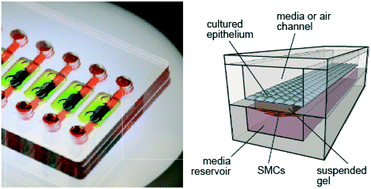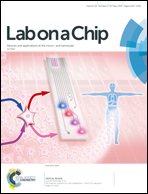Microfluidic lung airway-on-a-chip with arrayable suspended gels for studying epithelial and smooth muscle cell interactions
Abstract
Chronic lung diseases (CLDs) are regulated by complex interactions between many different cell types residing in lung airway tissues. Specifically, interactions between airway epithelial cells (ECs) and airway smooth muscle cells (SMCs) have been shown in part to play major roles in the pathogenesis of CLDs, but the underlying molecular mechanisms are not well understood. To advance our understanding of lung pathophysiology and accelerate drug development processes, new innovative in vitro tissue models are needed that can reconstitute the complex in vivo microenvironment of human lung tissues. Organ-on-a-chip technologies have recently made significant strides in recapitulating physiological properties of in vivo lung tissue microenvironments. However, novel advancements are still needed to enable the study of airway SMC–EC communication with matrix interactions, and to provide higher throughput capabilities and manufacturability. We have developed a thermoplastic-based microfluidic lung airway-on-a-chip model that mimics the lung airway tissue microenvironment, and in particular, the interactions between SMCs, ECs, and supporting extracellular matrix (ECM). The microdevice is fabricated from acrylic using micromilling and solvent bonding techniques, and consists of three vertically stacked microfluidic compartments with a bottom media reservoir for SMC culture, a middle thin hydrogel layer, and an upper microchamber for achieving air–liquid interface (ALI) culture of the epithelium. A unique aspect of the design lies in the suspended hydrogel with upper and lower interfaces for EC and SMC culture, respectively. A mixture of type I collagen and Matrigel was found to promote EC adhesion and monolayer formation, and SMC adhesion and alignment. Optimal culturing protocols were established that enabled EC–SMC coculture for more than 31 days. Epithelial monolayers displayed common morphological markers including ZO-1 tight junctions and F-actin cell cortices, while SMCs exhibited enhanced cell alignment and expression of α-SMA. The thermoplastic device construction facilitates mass manufacturing, allows EC–SMC coculture systems to be arrayed for increased throughput, and can be disassembled to allow extraction of the suspended gel for downstream analyses. This airway-on-a-chip device has potential to significantly advance our understanding of SMC–EC–matrix interactions, and their roles in the development of CLDs.

- This article is part of the themed collections: Lab on a Chip Emerging Investigators and Organ-, body- and disease-on-a-chip systems


 Please wait while we load your content...
Please wait while we load your content...